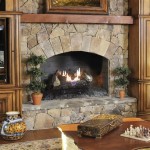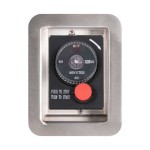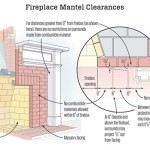Antique Iron Fireplace Screen: A Timeless Blend of Protection and Artistry
Antique iron fireplace screens represent more than mere functional accessories; they are historical artifacts that embody the craftsmanship and aesthetic sensibilities of past eras. These screens, designed to both protect a room from flying embers and enhance the visual appeal of a fireplace, offer a tangible connection to bygone days. Their durability, intricate designs, and enduring presence in homes and collections attest to their inherent value and appeal.
The history of fireplace screens is inextricably linked to the evolution of heating technology and interior design. Early fireplaces, often large and open, posed considerable risks of spreading sparks and embers. The development of fireplace screens addressed this safety concern while simultaneously providing an opportunity for artistic expression. Initially crafted from simple materials, these screens gradually evolved in complexity and ornamentation, reflecting the changing tastes and technological advancements of each period. Iron, prized for its strength and malleability, became a favored material, allowing artisans to create intricate patterns and durable structures.
The journey of an antique iron fireplace screen from its creation to its present-day preservation often involves traversing time, witnessing shifts in ownership and adaptation to different environments. The preservation of these screens involves a delicate balance between maintaining their historical integrity and ensuring their continued functionality or aesthetic appeal. Understanding their construction, design elements, and the historical periods from which they originate is crucial for appreciating their significance and making informed decisions regarding their care and restoration.
The Evolution of Iron Fireplace Screen Designs
The design evolution of antique iron fireplace screens mirrors the broader trends in decorative arts and architectural styles. Early examples, often dating from the 17th and 18th centuries, tended to be relatively simple, prioritizing functionality and safety. These screens often featured basic geometric patterns or openwork designs that allowed for ample heat radiation while preventing sparks from escaping. The materials used were primarily wrought iron, carefully hammered and shaped by skilled blacksmiths.
As the 19th century progressed, fireplace screen designs became increasingly elaborate and ornate. The Victorian era, in particular, witnessed a surge in the popularity of cast iron screens, which allowed for more intricate and mass-produced designs. These screens often featured elaborate floral motifs, scrolling patterns, and even depictions of animals or historical scenes. The use of cast iron facilitated the creation of more complex and three-dimensional designs, adding a layer of visual richness to the fireplace.
The Arts and Crafts movement of the late 19th and early 20th centuries brought a renewed emphasis on handcrafted designs and natural materials. Fireplace screens from this period often featured simpler, more organic forms, reflecting a rejection of the mass-produced ornamentation of the Victorian era. Wrought iron remained a popular material, and designs often incorporated elements inspired by nature, such as leaves, vines, and stylized flowers. The emphasis was on craftsmanship and the inherent beauty of the materials used.
The Art Deco period of the 1920s and 1930s brought a new wave of geometric and stylized designs to fireplace screens. These screens often featured sleek lines, bold geometric patterns, and the use of materials such as chrome and polished steel in conjunction with iron. The Art Deco style emphasized modernity and sophistication, and fireplace screens from this period reflected this aesthetic.
Identifying and Authenticating Antique Iron Fireplace Screens
Identifying and authenticating antique iron fireplace screens requires a combination of knowledge, careful observation, and sometimes, expert consultation. Several key factors can help distinguish an authentic antique screen from a reproduction or later imitation. The material itself is a primary indicator; wrought iron, with its distinctive texture and hand-forged appearance, is characteristic of earlier screens, while cast iron, with its smoother surface and more precise detailing, is more common in later examples.
The design and ornamentation of the screen can also provide valuable clues about its age and origin. Researching the prevailing styles of different historical periods can help determine whether the design is consistent with a particular era. Details such as the type of motifs used, the complexity of the patterns, and the overall aesthetic can all point to a specific timeframe. Examining the construction techniques used is also important. Hand-forged elements, such as rivets and joints, are indicative of earlier craftsmanship, while machine-made components suggest a later date.
The presence of maker's marks or foundry marks can be a significant aid in authentication. Many manufacturers of fireplace screens left their identifying marks on their products, providing a direct link to their origin. However, the absence of a mark does not necessarily indicate that a screen is not authentic, as not all manufacturers routinely marked their products.
The condition of the screen can also offer insights into its history and authenticity. Signs of wear and tear, such as rust, patina, and minor damage, are to be expected in antique items. However, excessive or inconsistent damage may indicate that the screen has been altered or repaired, which can affect its value and authenticity. Consulting with a qualified antique appraiser or specialist can provide valuable expertise in the authentication process. These professionals have the knowledge and experience to assess the screen's material, design, construction, and condition, and to determine its age and origin with greater accuracy.
Caring for and Preserving Antique Iron Fireplace Screens
The long-term preservation of antique iron fireplace screens requires a proactive approach to care and maintenance. Iron, while durable, is susceptible to rust and corrosion, particularly in environments with high humidity or exposure to water. Regular cleaning and protective measures are essential to prevent deterioration and maintain the screen's aesthetic appeal.
Cleaning an antique iron fireplace screen should be done carefully to avoid damaging the surface or any delicate ornamentation. A soft brush or cloth can be used to remove loose dust and debris. For more stubborn dirt or grime, a mild soap and water solution can be used, but it is crucial to ensure that the screen is thoroughly dried afterward to prevent rust. A specialized metal cleaner designed for antiques can also be used, following the manufacturer's instructions carefully.
Preventing rust is a key aspect of preserving antique iron. Applying a protective coating of wax or oil can help create a barrier against moisture and prevent corrosion. Renaissance Wax is a popular choice among collectors and conservators, as it provides a durable and protective finish without altering the appearance of the iron. Alternatively, a light coating of mineral oil can be applied to the surface, wiping off any excess. Regular inspection of the screen for signs of rust is essential. If rust is detected, it should be addressed promptly to prevent it from spreading.
Proper storage is also important for long-term preservation. If the screen is not in use, it should be stored in a dry, well-ventilated area. Wrapping the screen in acid-free paper or cloth can provide additional protection against dust and moisture. Avoiding exposure to direct sunlight or extreme temperatures can also help prevent damage. In cases where the screen has sustained significant damage, such as broken or missing components, professional restoration may be necessary. A qualified conservator can repair the damage while maintaining the screen's historical integrity. Restoration should be approached with caution, as overly aggressive or inappropriate techniques can diminish the screen's value and authenticity.

Old World Fireplace Screen Iron Accents

Acanthus Leaf Fireplace Screen 46 5 Wide Elegance Iron Accents

Valante Fireplace Screen Iron Accents

Old World Fireplace Screen Iron Accents

Broe Fireplace Screen Vintage Antique Style Wrought Iron 3 Panel Fire Guard

Vineyard Cast Iron Scroll Fireplace Screen Frontgate

A Pretty Wrought Iron Firescreen Antique Fireplaces And Surrounds Thornhill Galleries

Cast Iron Fireplace Screen Sold At Auction On 4th October Stair

Antique Rare Tiny English Forged Wrought Iron Fireplace Hearth Gate Screen Fender French Country Ornamental Architectural Landscape Denmark

Antique Arts Crafts Firescreen Fireplace Vintage Victorian Screens








